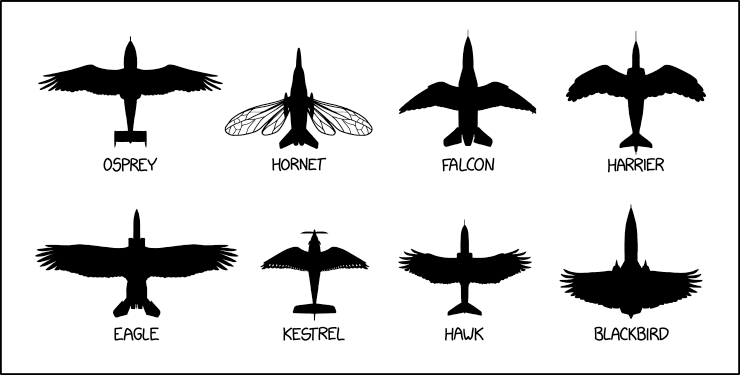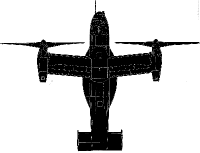1824: Identification Chart
| Identification Chart |
 Title text: Be careful-it's breeding season, and some of these can be *extremely* defensive of their nests. |
Explanation
Some aircraft are named after creatures of flight, including birds of prey, other birds, and insects. This comic spoofs an "identification guide" of bird silhouettes, each with the fuselage of an aircraft and the wings of the flying animal from which the aircraft gets its name. All are birds with the exception of the hornet which is an insect, see the table below for individual explanations.
This idea of having feathers wings on a plane is absurd, as bird wings (for birds that can fly) are made to support the lightweight structure of a bird. Supporting the metal parts of a plane along with its human pilot would be impossible.
General military training often includes aircraft identification. Silhouette charts are given to ground observers for memorization and reference so that friend or foe can be determined in the field. Conversely, many bird watching books will carry pictures of avian silhouettes from below, as often key details like tail and wing shape are the easiest way to determine what a species a high soaring bird is, especially birds of prey.
The comic highlights not only the various designs of aircraft tails, but also bird wings. Some wings are highly adapted for soaring (eagle), speed (falcon), as well as rapid acceleration and short flights (blackbird).
The title text is juxtaposing military air bases with breeding nests of the animals--both of which might earn a hostile response to approach at the wrong time, but in wildly different measure. Encroaching on breeding territory of some of the birds being referenced may result in getting dived at or chased, so the comparison invites the reader to imagine what might happen if the analogous creatures in the comic were defending their nest with aircraft ordnance.
Table
| Animal | Plane | Description |
|---|---|---|
| Osprey | V-22 Osprey | The osprey (Pandion haliaetus) is a raptor with distinctive white and brown coloring. It's also sometimes referred to as a sea hawk or fish eagle due to its virtually all fish diet.
The V-22 Osprey is a tilt-rotor aircraft that has been in development since the 1980s, and was introduced to the U.S. Armed Forces in 2007. It's a troop carrier aircraft that combines the vertical take-off ability of a helicopter with the high cruising speed of an airplane. (Bell Helicopter and Boeing) |
| Hornet | F/A-18 Hornet | Hornets are a type of wasp of the genera vespa or provespa. They're known to be highly territorial and aggressive.
The F-18 Hornet is a fighter developed for the Navy in the 1970s. It's been deployed by air forces around the world in both air-to-air and air-to-ground roles, and is flown by the US Navy demonstration team, the Blue Angels. The airplane is still being produced in an updated and larger version, the F/A-18E/F Super Hornet. (McDonnell Douglas) |
| Falcon | F-16 Falcon | A falcon is a bird of prey known for its tapered wings that allow for high speed flight and high maneuverability.
The F-16 Falcon is a light single-engine fighter. It's flown by the USAF demonstration team, the Thunderbirds. (General Dynamics) |
| Harrier | AV-8B Harrier | A harrier is a hawk that hunts by flying low over open ground.
The first operational STOL/VTOL fighter. They are known for their use in the Falklands War (1982), where they operated from converted cargo ships as well as aircraft carriers. (Hawker Siddeley) |
| Eagle | F-15 Eagle | Eagle is a common name for many large birds of prey of the family Accipitridae.
Introduced in 1976, other jets like F-16 have filled its role. The U.S. Air National Guard is the largest operator as of now. (McDonnell Douglas) |
| Kestrel | Kestrel K-350 | A bird of prey that can hover before swooping in on its prey.
The Kestrel is a single-engine, proof-of-concept aircraft, similar to the Pilatus PC-12. (Kestrel Aircraft) |
| Hawk | Hawk T1 | A hawk is a large bird of prey with a heavy head and beak. They have very acute vision.
A trainer aircraft. T-45 Goshawk is the U.S. designation of a variant of this aircraft. The fuselage silhouette is of a BAe Hawk, although other aircraft have also had Hawk-related names, for example the Hawker Sea Hawk and the Douglas A-4 Skyhawk. (BAE Systems) |
| Blackbird | SR-71 Blackbird | A Mach 3+ spy aircraft, known for its speed and engine design (which allowed them to work both as turbines and ramjets). (Lockheed Martin) |
Transcript
Osprey Hornet Falcon Harrier Eagle Kestrel Hawk Blackbird
Discussion
Clearly these are the flappy planes from https://www.xkcd.com/1322/
Birdwatchers have a technique for identifying birds by silhouette called Giss (pronounced Jizz) it stands for General Impression, size, and shape During WWI-II peacetime birdwatchers used the same technique to spot and call or planes. Think it could be a reference to that? 4/17/2017
Hi, I have partially added a table, can someone who is better at tables fill it in? Thanks.Dontknow (talk) 04:42, 14 April 2017 (UTC)
I was in Cambridge last week and an Osprey cruised overhead at a very low altitude. Was seriously cool to see. Randall lives nearby. Perhaps that's what inspired this comic? 162.158.75.94 06:43, 14 April 2017 (UTC)
When I saw "Hawk" I thought of a Cessna 172 Skyhawk. RChandra (talk) 10:54, 14 April 2017 (UTC)
- That could also be referencing the A-4 Skyhawk (chart updated) 172.68.65.138
Corrected some spellings and made the English a bit more idiomatic. Hypersonic is usually considered Mach 5 and higher, so altered that as the SR71 was fast but not that fast. Added reference to the Hawker Sea Hawk to the Hawk discussion, but the silhouette is clearly a BAe Hawk (tailplanes different shape from A4 Skyhawk or Hawker Sea Hawk, and a jet unlike the Cessna).
[F-15]: "other jets like F-16 have filled its role. The U.S. Air National Guard is the largest operator as of now." The F-15 is a current, front-line fighter. Only older models are in the ANG.
[F-16]: "A smaller, more versatile fighter jet." Just smaller.
- Falcons are most definitely more versatile if you include everything it can do in Iron Eagle (irony noted). Although the Air Force would not allow for American F-16s to be used in the movie, for obvious reasons - mainly proliferating the idea that the Air Force is so inept that a reservist Lieutenant Colonel and a high school senior can commandeer two fully loaded F-16s, fly them halfway around the world (from what looks like California to a generic Middle Eastern country), engage in an act of war by firing at another country's planes, rescue said high schooler's father, and make it back. And then the kid still somehow is able to avoid any time at Leavenworth and actually makes it into the Air Force Academy.
Could this comic be a continuation of where Randall believes we are heading? The direction of our country, and the world? It seems a warning.
Reminds me of a how Navajo code talkers used the names of birds in place of different aircraft (eg, the Navajo word for "hummingbird" was code for "fighter plane").108.162.237.178 15:00, 14 April 2017 (UTC)
Should we reference this XKCD/What-If page, which has a similar drawing: https://what-if.xkcd.com/149/
Actually, that was comparing actual birds with a plane thrown in for humour. This is different. Dontknow (talk) 23:44, 17 April 2017 (UTC)
The F/A-18 is most likely an A/B/C/D variant as opposed to the E/F Super Hornet, based on the smaller LERX (leading-edge root extensions), whereas the Super Hornets have very large LERX.
Real images of birds (and an insect) and aircrafts
Real silhouette of an V-22 Osprey aircraft: --JakubNarebski (talk) 19:48, 16 April 2017 (UTC)Politics?
There is no reason to believe this comic is political, or that it has anything to do with Trump-induced sadness. Why force politics where it doesn't belong? 172.68.154.64 07:44, 24 April 2017 (UTC)

